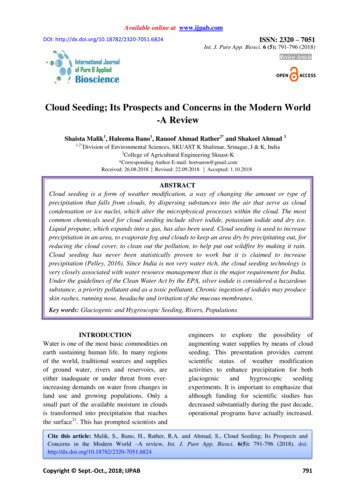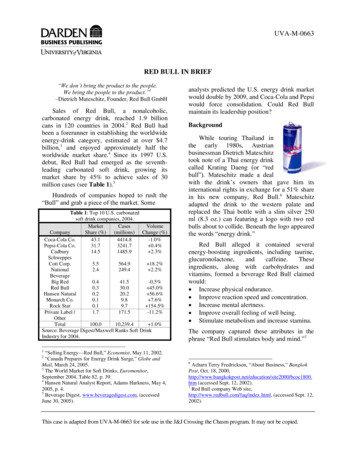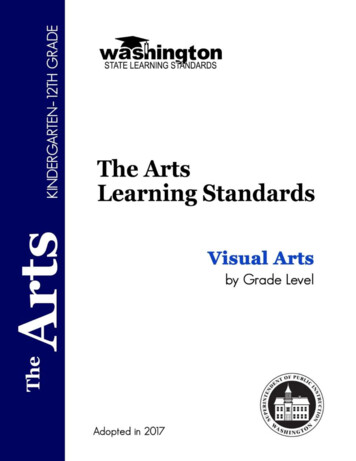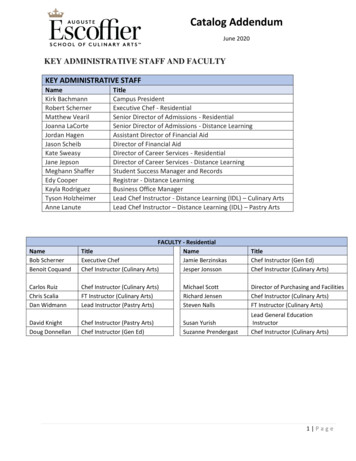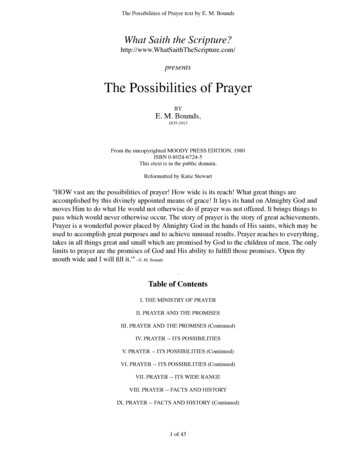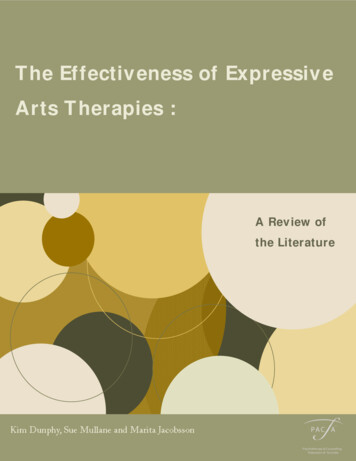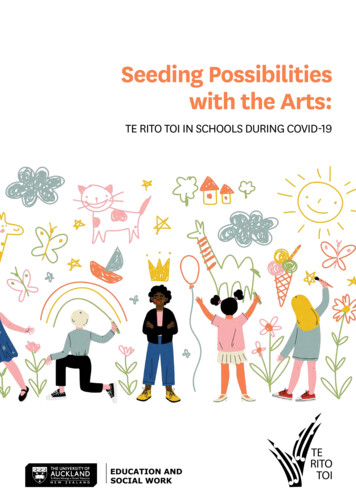
Transcription
Seeding Possibilitieswith the Arts:TE RITO TOI IN SCHOOLS DURING COVID-19TERITOTOI
CONTENTSEXECUTIVESUMMARYBUILDING ARESPONSE TOCOVID-19:TE RITO TOITHE STUDYWHY DIDSCHOOLS USETE RITO TOI?WHAT DIDTE RITO TOIFACILITATE?HOW DIDSCHOOLS USETE RITO TOI?WHAT MADETHE USE OFTE RITO TOIPOSSIBLE?AFTERCOVID-19,WHAT COMESNEXT?CONCLUSIONCONTENTS2Executive summary4Foreword5Building a response to Covid-19: Te Rito Toi6The Study8Findings:Why did schools use Te Rito Toi?Human response to lockdowns: arts and wellbeing1010What did Te Rito Toi facilitate?Building relationshipsSense making and connecting with real worldDialogueHope in the futureSafety131315161819Seeding possibilities with the arts: Te Rito Toi in schools during Covid-19How did schools use Te Rito Toi?Resources usedAdaptationsLimitations and difficulties20202030What made the use of Te Rito Toi possible?Social consensus on wellbeingSupport from NZEI, NZPF and UNESCOProfessional development in arts educationStep-by-step proposalsResearch-based resources323233333334After Covid-19, what comes next?35Conclusion37References38REFERENCES
CONTENTSEXECUTIVESUMMARYBUILDING ARESPONSE TOCOVID-19:TE RITO TOITHE STUDYWHY DIDSCHOOLS USETE RITO TOI?WHAT DIDTE RITO TOIFACILITATE?HOW DIDSCHOOLS USETE RITO TOI?WHAT MADETHE USE OFTE RITO TOIPOSSIBLE?AFTERCOVID-19,WHAT COMESNEXT?CONCLUSIONREFERENCESAcknowledgementsWe thank the following for their generous support of the Centre for Arts and Social Transformation to conduct thisresearch into Te Rito Toi: Cognition Education TrustChelmer LtdThe Chartwell TrustWe are indebted to the team at the Centre for their support in multiple phases of the report: Christa Napier-RobertsonKelcey Roberts, Iris Leng, Tahnee Vo, and Caitlin PerezMany thanks to Professor Carol Mutch, Education Commissioner for the New Zealand National Commission toUNESCO for her ongoing support.We also thank the teachers and principals for their willingness to share their experiences of working with Te Rito Toi.Professor Peter O’Connor and Dr Marta EstellésCentre for Arts and Social Transformation, June 2021.Please cite this document as: O’Connor, P., & Estellés, M. (2021). Seeding Possibilities with the Arts: Te Rito Toi in Schoolsduring Covid-19 (Research Report). Auckland, New Zealand: The University of Auckland.3
CONTENTSEXECUTIVESUMMARYBUILDING ARESPONSE TOCOVID-19:TE RITO TOITHE STUDYWHY DIDSCHOOLS USETE RITO TOI?WHAT DIDTE RITO TOIFACILITATE?HOW DIDSCHOOLS USETE RITO TOI?WHAT MADETHE USE OFTE RITO TOIPOSSIBLE?AFTERCOVID-19,WHAT COMESNEXT?CONCLUSIONExecutive summaryResearch contextIn March 2020, all schools in Aotearoa New Zealand closed as the country went into seven weeks oflockdown. During this time, a group of academics, artists and educational practitioners came together tocreate Te Rito Toi, an online resource aimed at providing arts- and research-based classroom support forteachers in their return to school. Shortly after its launch, Te Rito Toi had over 250,000 visits and gainedinternational recognition from UNESCO, the World Alliance of Arts Educators and the OECD. The webinarsthat introduced Te Rito Toi during the New Zealand Covid-19 lockdown were attended by over 30,000teachers. This report examines the use of Te Rito Toi in New Zealand schools following the Covid-19lockdown. It explores the ways in which educators adapted the resources to their own needs and theoutcomes derived from its use. It also identifies the key factors that made the arts in schools possible.The implications of this study for future crises are considered at the end of the report.Key findingsThis research shows:Key recommendations forschools and policy makers: To replace the ‘going back to normal’ approach with a focuson wellbeing for schools in post crisis recovery. To endorse initiatives like Te Rito Toi to guarantee that thearts and wellbeing become the focus of schools in futurecrises. To provide culturally and socially diverse resources forclassroom teachers to help students cope with majorevents. To invest in professional development in arts education andwellbeing post crisis. To include education on the possibility of unexpected eventsin pre-service teacher programmes and to provide supporton appropriate pedagogical responses. To actively involve teachers and principals in emergencyplanning and training. 4Te Rito Toi offered the educators involved in the studythe possibility to put student wellbeing at the centre ofschool life after lockdown, filling a gap in the New Zealandeducational response to the Covid-19 pandemic.The social consensus around wellbeing through the artsgave teachers the necessary confidence to prioritise studentwellbeing over other academic goals.Te Rito Toi provided ways for children to build relationships,explore emotions, have fun, make sense of the world andrenew hope in the future. Teachers creatively adapted the resources to the interests oftheir students and, in many cases, students took the leadingrole in such adaptations. Teachers and principals had a very positive view of thepedagogical value of Te Rito Toi, but also identified someimportant limitations. In particular, they suggested includingmore culturally and socially diverse resources. The teachers that had, at least, some professionaldevelopment in the arts and/or mental health educationwere able to make better use of Te Rito Toi following theCovid-19 lockdown. To a large extent, the participants were aware of Te Rito Toithanks to the support of educational organisations such asthe New Zealand Principals Federation, the New ZealandEducational Institute (the primary teachers union) and theNew Zealand National Commission for UNESCO.Seeding possibilities with the arts: Te Rito Toi in schools during Covid-19REFERENCES
CONTENTSEXECUTIVESUMMARYBUILDING ARESPONSE TOCOVID-19:TE RITO TOITHE STUDYWHY DIDSCHOOLS USETE RITO TOI?WHAT DIDTE RITO TOIFACILITATE?HOW DIDSCHOOLS USETE RITO TOI?WHAT MADETHE USE OFTE RITO TOIPOSSIBLE?AFTERCOVID-19,WHAT COMESNEXT?CONCLUSIONREFERENCESForewordGood ideas take time to come to fruition. They might begin with someone noticing a problem andmulling over possible solutions. Or they might begin with someone identifying an issue that could arisein the future and asking, “what if?” Te Rito Toi is the response to a what-if question that took ten yearsto germinate. After the Canterbury earthquakes, Peter O’Connor and I, independently, found ourselvesworking with Christchurch schools to enable children to process the traumatic events they had faced.Peter asked himself, “What if I could find a way to assist teachers to help children make sense of theenormity of what has happened?” Through the Teaspoon of Light programme students supported afictional character to repair her torn cloth of dreams. As they did so, they came to untangle their ownanxieties. I asked, “What if schools could record their stories and we could be better prepared for futuredisasters?” Using my participatory research skills, I helped schools capture their experiences and detailthe impact on principals, teachers, students and their families.Fast forward to January 2020 and Peter and I were both invitedto Sydney to use our earthquake experiences to advise Australianschools in the aftermath of that summer’s devastating bushfires.The subsequent Banksia Initiative drew on Peter’s creativeactivities to help children process their emotions and my advicefor principals and teachers on what to do on their return to school.On the flight home, Peter said, “What if we could do the same forNew Zealand schools?” Within a short space of time, Covid-19arrived and the country was plunged into lockdown. Schools wereclosed and students began learning from home. When it was timefor schools to reopen, the what-if became a reality. Peter workedtirelessly to pull together Te Rito Toi. However, it would not havebeen possible without the generosity of funders, supporters andcontributors. Not only did grateful New Zealand principals andteachers find that there was evidence-based advice and readymade resources to support their return to school but the websiteattracted interest from across the globe and the resources weredownloaded hundreds of thousands of times.This report shares some of the initial findings from a qualitativestudy that investigated how teachers used the resource, whatworked well and what might be improved. It highlights theimportance of the availability of quality support in the aftermathof a crisis – great or small – and the need for the support to berelevant, engaging and easily accessible. I can attest, first-hand,to the quality of the resources, knowing that they are underpinnedby the latest research and trialled by experienced practitioners.I feel confident that Te Rito Toi provides a model for how othereducational jurisdictions might support schools when the nextdisaster strikes. It gives me great pleasure to write this foreword,to celebrate what has been achieved, and to congratulate all thoseinvolved. This is a fine example of collaboration and innovationand our children and young people will only be the better for it.Dr Carol Mutch,Professor of Critical Studies in EducationEducation Commissioner for the New Zealand NationalCommission to UNESCO.“ TE RITO TOI IS THERESPONSE TO AWHAT-IF QUESTIONTHAT TOOK TEN YEARSTO GERMINATE.”5
CONTENTSEXECUTIVESUMMARYBUILDING ARESPONSE TOCOVID-19:TE RITO TOITHE STUDYWHY DIDSCHOOLS USETE RITO TOI?WHAT DIDTE RITO TOIFACILITATE?HOW DIDSCHOOLS USETE RITO TOI?WHAT MADETHE USE OFTE RITO TOIPOSSIBLE?AFTERCOVID-19,WHAT COMESNEXT?CONCLUSIONBuilding a response to Covid-19:Te Rito ToiIn March 2020, all schools in Aotearoa New Zealand closed as the country went into seven weeks oflockdown where physical isolation applied to all aspects of life. Schooling went online. In the first week oflockdown, a team at the University of Auckland realised that schools would eventually reopen and thatthere would be a real need for teachers to have research-informed resources to shift their curriculumand pedagogy to meet the extraordinary times. A team of writers across Aotearoa New Zealand andAustralia took the time during New Zealand’s extensive and strict seven-week lockdown to create uniquearts-based resources designed specifically as a response to Covid-19. Central to this project was anunderstanding that arts-informed curricular approaches provide powerful methods for individual andcommunity recovery during and after disaster and that participatory arts-based methods strengthensocial support and help people to build critical hope (O’Connor, 2013).CENTRAL TO THIS PROJECTWAS AN UNDERSTANDINGTHAT ARTS-INFORMEDCURRICULAR APPROACHESPROVIDE POWERFULMETHODS FOR INDIVIDUALAND COMMUNITY RECOVERYDURING AND AFTER DISASTER.6Seeding possibilities with the arts: Te Rito Toi in schools during Covid-19The writers were tasked to create lesson plans that providedcreative and safe ways to explore the anxieties and issues childrenmight return to school with. As arts educators, they knew the artsuniquely protect participants into, not from, emotion. Gavin Boltonargues that the purpose of providing spaces through the arts fordialogue is not so that emotional response is removed from thesituation, rather the space allows an opportunity for people to feelin a safe manner (Bolton, 1986).The team of writers created a series of lesson plans focusing onanxiety. A set of picture books created by Professor Carol Mutchabout a toy bear in lockdown provided a narrative setting forchildren to affectively explore the lockdown experience throughthe fictional account of the bear. A series of lessons provided byThe Poutokomanawa Project centred around the use of Māori art(nga toi) forms to re-engage children with the classroom. TheMāori forms that blend music, dance, theatre and the visual artstogether were designed to rebuild confidence in how classroomsmight move together physically after months of isolation.Arts education experts, Professor Julie Dunn and ProfessorJohn O’Toole from Australia, adapted materials to providerich sophisticated drama lessons. Ginnie Thorner who led theTeaspoon of Light Theatre in Education Company in Christchurchafter the earthquakes provided dance and visual arts lessonsthat focused on making sense of social distancing. Poet Laureate,Associate Professor Selina Tusitala-Marsh, created a poetry lessonto celebrate the capacity to be an everyday hero. These resourceswere the first substantial curriculum resources in the arts andwellbeing for Primary schools in at least fifteen years. ProfessorCarol Mutch, based on extensive research in schools post-disaster,provided detailed advice for teachers and principals (see Mutch,2014, 2015; Fletcher & Nicholas, 2016) and Briar O’Connor usedher PhD studies to provide advice around family violence and childabuse post-Covid-19.REFERENCES
CONTENTSEXECUTIVESUMMARYBUILDING ARESPONSE TOCOVID-19:TE RITO TOITHE STUDYWHY DIDSCHOOLS USETE RITO TOI?WHAT DIDTE RITO TOIFACILITATE?In naming our project, we turned to metaphors to be found innature. The rito, is the seedling that sits at the centre of theharakeke bush, a plant endemic to New Zealand. If hurt, theseedling, and then the plant, dies. The rito is kept safe by theleaves that surround it. Te Rito Toi recognises how the seed ofthe arts that start when we are young needs to be protected andthat the arts also protect and help nourish the young. At a timeof crisis, Te Rito Toi reminds us of the power of metaphor, of thegrace and beauty to be found in understandings that derive fromthe natural and Māori worlds. The project is indebted to MichaelSteedman, Ngāti Whātua o Ōrākei, Ngāti Whātua, Te Uri o Hau,Kaiarataki at the University of Auckland for gifting this poetic andbeautiful name that is now known around Aotearoa New Zealandand the world.HOW DIDSCHOOLS USETE RITO TOI?WHAT MADETHE USE OFTE RITO TOIPOSSIBLE?AFTERCOVID-19,WHAT COMESNEXT?CONCLUSIONREFERENCESAT A TIME OF CRISIS, TE RITOTOI REMINDS US OF THE POWEROF METAPHOR, OF THE GRACEAND BEAUTY TO BE FOUNDIN UNDERSTANDINGS THATDERIVE FROM THE NATURALAND MĀORI WORLDS.With endorsement from the New Zealand Principals Federation(NZPF; the organisation that represents all school principalsacross the country), New Zealand Educational Institute (NZEI;the Primary teachers union) and part funding from New ZealandNational Commission for UNESCO, Te Rito Toi was launchedalongside webinars that introduced the resource to over 30,000teachers in Aotearoa New Zealand and Australia. Launched onApril 24 2020 as schools prepared to reopen in the first month ofit being online, over 37,000 teachers accessed the site with over250,000 page views. As a result, the arts and wellbeing becamethe focus for many students as they returned to school in AotearoaNew Zealand and Australia. A global push for this approach waspicked up by UNESCO and the World Alliance of Arts Educators sothat by the end of 2020 the site had been viewed and used in 114countries with over 320,000-page views.Up to date, Te Rito Toi has also gained international recognitionfrom the OECD (see van Lieshout, 2020) and inspired educationalinitiatives in several countries, including Hong Kong (Tam, 2020),Norway and Hungary (Cziboly & Bethlenfalvy, 2020).7
CONTENTSEXECUTIVESUMMARYBUILDING ARESPONSE TOCOVID-19:TE RITO TOITHE STUDYWHY DIDSCHOOLS USETE RITO TOI?WHAT DIDTE RITO TOIFACILITATE?HOW DIDSCHOOLS USETE RITO TOI?WHAT MADETHE USE OFTE RITO TOIPOSSIBLE?AFTERCOVID-19,WHAT COMESNEXT?CONCLUSIONThe StudyThe study presented in this report aims to explore the use of Te Rito Toi in New Zealand schools followingthe Covid-19 lockdowns. In particular, this study addresses the following questions:1.Why did New Zealand schools use Te Rito Toi after theCovid-19 lockdowns?2.What did the use of Te Rito Toi facilitate?3.How did New Zealand schools use Te Rito Toi?4.What made the use of Te Rito Toi at NZ schools possible?During the last term of the 2020 academic year, the researchteam immersed themselves in eight schools across AotearoaNew Zealand and conducted semi-structured interviews withprincipals, teachers and/or team leaders who were involved in theuse or promotion of the Te Rito Toi resources. The eight schoolsthat participated in the research project were diverse in termsof school type, location, number of pupils and socio-economicstatus (see Table 1). The schools were engaged in the participantselection, data gathering and sense-making processes. Theparticipants were recruited for both being willing to participate inthe study and having used or promoted the Te Rito Toi resourceswhen returning to school after the Covid-19 lockdowns. A total of15 principals, teachers and team leaders were actively involved inthe study.The study used a participatory, qualitative case study designunderpinned by a constructivist theoretical framework(Burr, 2015). The researchers and participants co-constructeda detailed case study (Stake, 1995) of each school’s experience,prior to the cross-case analysis.Table 1. Characteristics of the schoolsSCHOOL CHARACTERISTICSSchool 1School 2School 3School 4Large city – North IslandLarge city – North IslandLarge city – North IslandState co-edState co-edState co-ed9110LOCATIONLarge city – North IslandSCHOOL TYPEState integrated, catholic,co-edDECILE1NUMBER OF c2%Other6%Samoan4%Other14%Tongan4%Other3%Source: Own elaboration based on data from the Education Review Office website.8298MāoriSeeding possibilities with the arts: Te Rito Toi in schools during Covid-19REFERENCES
CONTENTSEXECUTIVESUMMARYBUILDING ARESPONSE TOCOVID-19:TE RITO TOITHE STUDYWHY DIDSCHOOLS USETE RITO TOI?WHAT DIDTE RITO TOIFACILITATE?HOW DIDSCHOOLS USETE RITO TOI?WHAT MADETHE USE OFTE RITO TOIPOSSIBLE?AFTERCOVID-19,WHAT COMESNEXT?CONCLUSIONREFERENCEScompared between interviews in an iterative process. Then, theconstant comparative method was used across focused codingand developing categories (Charmaz, 2014). The data analysiswas conducted with the help of NVivo software.The methods for data collection included semi-structuredinterviews and artefact analysis of the products that resultedfrom the schools’ work with Te Rito Toi. The interviews startedwith questions about the background of the participants and theschool and then led into specific questions about their experienceas educators during Covid-19 lockdowns and the use of Te RitoToi when returning to school. The interviews lasted between40 and 60 minutes. They were recorded and transcribed in full.Participants were asked for feedback on the transcriptions.This research project obtained the ethical approval of theUniversity of Auckland Human Participants Ethics Committee(Ref. 2816). Participation in the research was completelyvoluntary and informed. A Participant Information Sheet wasprovided, and participants signed a Consent form to participatein the study. To ensure anonymity, none of the participants orschools have been identified by name in the research report.Data was open coded using thematic analysis of each caseand across cases by the constant comparative method. Thisanalysis began with initial coding (Charmaz, 2014), where thecontributions of each participant were analysed line-by-line andgiven an initial code. The initial codes of each interview wereSCHOOL CHARACTERISTICSSchool 5School 6School 7School 8Regional city –South IslandLarge city – North IslandSmall town – North IslandState co-edState co-edState integrated, catholic,co-ed10410LOCATIONRegional city– South IslandSCHOOL TYPEState co-edDECILE9NUMBER OF PUPILS470171401184Māori8%Māori & er7%Cook Island Māori5%Other15%Other18%9
CONTENTSEXECUTIVESUMMARYBUILDING ARESPONSE TOCOVID-19:TE RITO TOITHE STUDYWHY DIDSCHOOLS USETE RITO TOI?WHAT DIDTE RITO TOIFACILITATE?HOW DIDSCHOOLS USETE RITO TOI?WHAT MADETHE USE OFTE RITO TOIPOSSIBLE?AFTERCOVID-19,WHAT COMESNEXT?CONCLUSIONWhy did schools use Te Rito Toi?Human response to lockdowns:arts and wellbeingFor most of the teachers and principals interviewed, the firstCovid-19 lockdown was an extremely challenging period aseducators. It was not only the unprecedented nature of thesituation causing high levels of stress and anxiety. It was alsoknowing, or at least suspecting, that some students wereexperiencing truly difficult times. This reality was particularly acutein low-decile schools. As the following teacher from adecile 1 school explained to us:“It [lockdown] was very hard because most of our job isjust being there for children, in their learning and in theireveryday lives. So that was difficult [ ] I didn’t feel I wasgetting a very good idea of exactly how things were going forall the children. Some children we didn’t hear from until wewere back in Level 2. And some children I heard from everyday, I saw them on Zoom, I saw them on our online class;parents texted and called, but then for others, it wasn’tthe case. And those children who were on my mind, I wasthinking: ‘Are they okay?’ ‘Are their families okay?’ And sothat caused a lot of anxiety for me, about their wellbeing.”10Seeding possibilities with the arts: Te Rito Toi in schools during Covid-19“ IT [LOCKDOWN] WAS VERYHARD BECAUSE MOST OFOUR JOB IS JUST BEINGTHERE FOR CHILDREN,IN THEIR LEARNING ANDIN THEIR EVERYDAY LIVES.SO THAT WAS DIFFICULT.”REFERENCES
CONTENTSEXECUTIVESUMMARYBUILDING ARESPONSE TOCOVID-19:TE RITO TOITHE STUDYWHY DIDSCHOOLS USETE RITO TOI?WHAT DIDTE RITO TOIFACILITATE?HOW DIDSCHOOLS USETE RITO TOI?WHAT MADETHE USE OFTE RITO TOIPOSSIBLE?AFTERCOVID-19,WHAT COMESNEXT?CONCLUSIONREFERENCES“ THE TEACHERS WERE USING THE RESOURCES FROM TE RITO TOITO ACTUALLY BRING THE CHILDREN BACK AND TO GET THEM TOTALK ABOUT WHAT IT HAD BEEN LIKE [BEING IN LOCKDOWN],THEY WERE LISTENING TO THESE STORIES BECAUSE WE HADSOME KIDS WHO WERE REALLY WORRIED THAT THEIR PARENTSWERE GOING TO DIE. [ ] AND IT WAS REALLY, JUST WHENPEOPLE CAME BACK AFTER THE FIRST LOCKDOWN, I JUST SEE IT,YOU KNOW, JUST HAVE FUN WITH OUR KIDS. AND, YOU KNOW,TAKE THE TIME AND TAKE THE TIME FOR THE CONVERSATION.SO TE RITO TOI WAS A GREAT SPRINGBOARD FOR THAT.”Aware of the critical circumstances some children faced duringlockdown, the educators involved in this study could not returnto school as if nothing had happened. At this moment, creatinga caring environment for students and building a sense ofcommunity became priorities over other academic goals relatedto literacy and numeracy. This was the main rationale behindresorting to Te Rito Toi. As the following teacher said:“I think after that first lockdown, schools were really thinkingabout social emotional learning, the common phrase thatI heard from teachers was that it was like starting the yearagain. So, at the beginning of every school year, we don’tlaunch into maths on the first day. At the beginning of theschool year, every teacher will take that time to build thatclassroom community. So what I heard, and what I saw wasthat teachers were basically rewinding the clock and treatingit like the beginning of the year, which is why the lessons thatwere on Te Rito Toi, the ideas and the suggestions that wereon Te Rito Toi were perfect for recreating, or creating thatpositive, safe, secure classroom environment. Because therewere children coming back who were anxious.”The idea of focusing on ‘bringing children back together’ recurredin interviews. The isolation circumstances created by lockdownshighlighted the importance of being together. The educatorsinvolved in this study understood that their professional andhuman response to the Covid-19 lockdowns needed to be basedon social (re)connection. For them, the arts provided a privilegedspace to achieve this aim. They used Te Rito Toi because theywere determined to put relationships and student wellbeingat the centre of school life. With this goal in mind, three of theprincipals interviewed encouraged the use of Te Rito Toi at thefirst staff meeting after lockdowns. See, for example, the followingquote from one of these principals whose school was locatedclose to one of the biggest Covid-19 outbreaks in Aotearoa NewZealand. As this principal explained, the educators of this schoolwere receptive to the children’s fears and anxieties regardingthe pandemic and student wellbeing became their pedagogicalpriority:“In one of our touch base sessions with all of the staff,we talked about it [Te Rito Toi] because the focus was onwellbeing and we were looking for things around wellbeingand creativity. So teachers just began to use it and [ ]the teachers were using the resources from Te Rito Toi toactually bring the children back and to get them to talkabout what it had been like [being in lockdown], they werelistening to these stories because we had some kids whowere really worried that their parents were going to die.[ ] And it was really, just when people came back after thefirst lockdown, I just see it, you know, just have fun with ourkids. And, you know, take the time and take the time for theconversation. So Te Rito Toi was a great springboardfor that.”Some teachers also recognised using Te Rito Toi provided creativeand humane ways to deal with the physical distancing measuresin place at the moment of returning to school. For instance, thefollowing teacher used the dance work ‘Hello again!’ in Te Rito Toito build social bonds, while remaining physically distant and safein health terms:“I chose the ‘Hello’ one because I thought it was quite agood way for them [children] to still be socially distanced,because we still had to be socially distant. But it got them outof the chairs and off the screen –because it was a full digitalclassroom. And so it was a great chance for them to closetheir computer screens and move around and say hello topeople that weren’t really in their friend group. And that’s whyI chose that one. And just because I thought it was a greatway to kind of relate it back to the fact that people wearingmasks and things like that, so they can’t see you smile or can’tsee you say hello and things like that. So I thought that wasa great chance to get them thinking about different ways tosay ‘hi’.”As the above quotes show, the main driving force to use Te RitoToi was the need for schools to provide a more human and caringresponse to the Covid-19 lockdowns.11
CONTENTS12EXECUTIVESUMMARYBUILDING ARESPONSE TOCOVID-19:TE RITO TOITHE STUDYWHY DIDSCHOOLS USETE RITO TOI?Seeding possibilities with the arts: Te Rito Toi in schools during Covid-19WHAT DIDTE RITO TOIFACILITATE?HOW DIDSCHOOLS USETE RITO TOI?WHAT MADETHE USE OFTE RITO TOIPOSSIBLE?AFTERCOVID-19,WHAT COMESNEXT?CONCLUSIONREFERENCES
CONTENTSEXECUTIVESUMMARYBUILDING ARESPONSE TOCOVID-19:TE RITO TOITHE STUDYWHY DIDSCHOOLS USETE RITO TOI?WHAT DIDTE RITO TOIFACILITATE?HOW DIDSCHOOLS USETE RITO TOI?WHAT MADETHE USE OFTE RITO TOIPOSSIBLE?AFTERCOVID-19,WHAT COMESNEXT?CONCLUSIONREFERENCESWhat did Te Rito Toi facilitate?In this section, we focus on the exchanges, connections, identifications, understandings and feelingsthat Te Rito Toi helped facilitate for the educators involved in the study. The tendency in most interviewswas to praise the pedagogical virtues of Te Rito Toi. We should clarify, however, that this section doesnot aim to idealise Te Rito Toi, but to explore its small contributions towards engaging students aslearners, citizens and human beings. These contributions are explored through the perspective of theeducators directly or indirectly involved in the use of Te Rito Toi. The complexity of pedagogical practicecannot be captured only through the perspective of the teachers, yet this perspective is indispensable tounderstanding what occurs in the classroom.Building relationshipsAs explained in the previous section, building relationships wasone of the main reasons why the educators that participated inthis study used Te Rito Toi. In many cases, a desire to praise thepedagogical virtues of Te Rito Toi seemed to take precedencein the conversation over providing concrete examples. In somecases, however, the teachers shared with us rich examples of howthe arts and Te Rito Toi helped them to work towards this purpose.The following teacher used the ‘Teaspoon of Light’ lesson plan,which is an arts project that starts with the first two lines of aspoken story: “A young girl wakes up to get ready to visit hergrandmother. As she gets up, she trips and tears her cloth ofdreams ”. The exercise of sharing feelings and experiencesthat the resource facilitated helped her students to relate andsympathise with each other:“I just know that the whole group appreciated having theopportunity to share how they were feeling and, in particular,using their emotions and putting them into body actions[with the drama]. Yeah, they could relate. And I think as wellthat, even though the drawing does help them to kind ofregroup as such, it was great to share it with their friends andthe conversations that they had with each other were reallyvaluable [ ] they’ve all gone through a similar experience,they relate, you know, even though their experience wasslightly differently because of their own families.”“ I JUST KNOW THAT THEWHOLE GROUP APPRECIATEDHAVING THE OPPORTUNITYTO SHARE HOW THEYWERE FEELING AND, INPARTICULAR, USING THEIREMOTIONS AND PUTTINGTHEM INTO BODY ACTIONS[WITH THE DRAMA]”“ WOW, THIS IS A REALLYGOOD, YOU KNOW, GOODTHING THAT WE’VE DONEJUST TO GET BACK, BUILDRELATIONSHIPS, TALK WITHEACH OTHER, YOU KNOW,GET BACK INTO SOCIETYA LITTLE BIT MORE”For the following teacher, a sign that Te Rito Toi facilitatedrelationships was children’s reluctance to use their electronicdevices afterwards. In the dialogue with the students that thisteacher reproduces in the following quote, it can be observed howstudents appreciated
lockdown. During this time, a group of academics, artists and educational practitioners came together to create Te Rito Toi, an online resource aimed at providing arts- and research-based classroom support for teachers in their return to school. Shortly after its launch, Te Rito Toi had over 250,000 visits and gained


